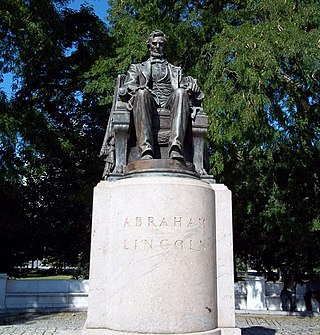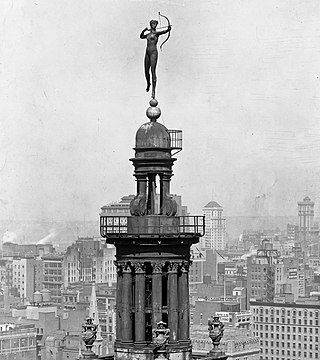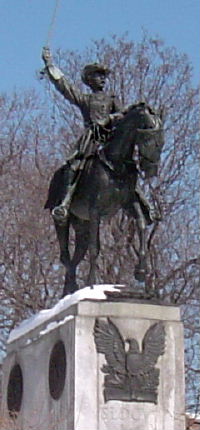
David Glasgow Farragut was a flag officer of the United States Navy during the American Civil War. He was the first rear admiral, vice admiral, and admiral in the United States Navy. He is remembered in U.S. Navy tradition for his bold order at the Battle of Mobile Bay, usually abbreviated to "Damn the torpedoes. .. full speed ahead."

Augustus Saint-Gaudens was an Irish and American sculptor of the Beaux-Arts generation who embodied the ideals of the American Renaissance. Saint-Gaudens was born in Dublin to an Irish-French family, and raised in New York City. He traveled to Europe for further training and artistic study. After he returned to New York City, he achieved major critical success for his monuments commemorating heroes of the American Civil War, many of which still stand. Saint-Gaudens created works such as the Robert Gould Shaw Memorial on Boston Common, Abraham Lincoln: The Man, and grand equestrian monuments to Civil War generals: General John Logan Memorial in Chicago's Grant Park and William Tecumseh Sherman at the corner of New York's Central Park. In addition, he created the popular historicist representation of The Puritan.

Madison Square is a public square formed by the intersection of Fifth Avenue and Broadway at 23rd Street in the New York City borough of Manhattan. The square was named for Founding Father James Madison, fourth President of the United States. The focus of the square is Madison Square Park, a 6.2-acre (2.5-hectare) public park, which is bounded on the east by Madison Avenue ; on the south by 23rd Street; on the north by 26th Street; and on the west by Fifth Avenue and Broadway as they cross.

The Adams Memorial is a grave marker for Marian Hooper Adams and Henry Adams located in Section E of Rock Creek Cemetery, Washington, D.C. The memorial features a cast bronze allegorical sculpture by Augustus Saint-Gaudens. Saint-Gaudens' shrouded-figure statue is seated against a granite block which takes up one side of a hexagonal plaza, designed by architect Stanford White. Across from the statue is a stone bench for visitors. The whole is sheltered by a close screen of dense conifers.

Abraham Lincoln: The Man is a larger-than-life size 12-foot (3.7 m) bronze statue of Abraham Lincoln, the 16th president of the United States. The original statue is in Lincoln Park in Chicago, and later re-castings of the statue have been given as diplomatic gifts from the United States to the United Kingdom, and to Mexico.

Albert Jaegers was an American sculptor.

Admiral David G. Farragut is a statue in Washington, D.C., honoring David Farragut, a career military officer who served as the first admiral in the United States Navy. The monument is sited in the center of Farragut Square, a city square in downtown Washington, D.C. The statue was sculpted by female artist Vinnie Ream, whose best-known works include a statue of Abraham Lincoln and several statues in the National Statuary Hall Collection. The monument was dedicated in 1881 in an extravagant ceremony attended by President James A. Garfield, members of his cabinet, and thousands of spectators. It was the first monument erected in Washington, D.C., in honor of a naval war hero.

Abraham Lincoln: The Head of State is a 9-foot (2.7 m) tall bronze statue of Abraham Lincoln in Grant Park, in Chicago. Created by Augustus Saint-Gaudens and completed by his workshop in 1908, it was intended by the artist to evoke the loneliness and burden of command felt by Lincoln during his presidency. The sculpture depicts a contemplative Lincoln seated in a chair, and gazing down into the distance. The sculpture is set upon a pedestal and a 150-foot (46 m) wide exedra designed by architect Stanford White.

The General William Tecumseh Sherman Monument is an equestrian statue of American Civil War Major General William Tecumseh Sherman located in Sherman Plaza, which is part of President's Park in Washington, D.C., in the United States. The selection of an artist in 1896 to design the monument was highly controversial. During the monument's design phase, artist Carl Rohl-Smith died, and his memorial was finished by a number of other sculptors. The Sherman statue was unveiled in 1903. It is a contributing property to the Civil War Monuments in Washington, D.C. and to the President's Park South, both of which are historic sites listed on the National Register of Historic Places.

Louis Saint-Gaudens was an American sculptor of the Beaux-Arts generation. He was the brother of renowned sculptor Augustus Saint-Gaudens; Louis later changed the spelling of his name to St. Gaudens to differentiate himself from his well-known brother.

The Puritan is a bronze statue by sculptor Augustus Saint-Gaudens in Springfield, Massachusetts, which became so popular that it was reproduced for over 20 other cities, museums, universities, and private collectors around the world, and later became an official symbol of the city, emblazoned on its municipal flag. Originally designed to be part of Stearns Square, since 1899 the statue has stood at the corner of Chestnut and State Street next to The Quadrangle.

Diana – also known as Diana of the Tower – is an iconic statue by sculptor Augustus Saint-Gaudens, representing the goddess Diana. Once a major artistic feature of New York City, the second version stood atop the tower of Madison Square Garden from 1893 to 1925. Since 1932, it has been in the collection of the Philadelphia Museum of Art.

The James A. Garfield Monument is a monument honoring the 20th president of the United States in Philadelphia, Pennsylvania, United States. Sculptor Augustus Saint-Gaudens and architect Stanford White collaborated on the memorial, which was completed in 1896. It is located in Fairmount Park, along Kelly Drive, near the Girard Avenue Bridge.

The Admiral David Glasgow Farragut Gravesite is the final resting place of David Glasgow Farragut (1801–1870), the first rear admiral, vice admiral, and four-star admiral of the United States Navy. He was most well known for his order to "Damn the torpedoes, full speed ahead." The granite and marble monument resembling a mast marks not only his burial site, but that of his wife, son and daughter-in-law. It was listed as a National Historic Landmark on the National Register of Historic Places on October 16, 2012. It is located in Woodlawn Cemetery in the Bronx, itself a National Historic Landmark. It is the only surviving place of high quality with a direct association to Farragut's life.

Edward Ludwig Albert Pausch was a Danish-American sculptor noted for his war memorials.

William Tecumseh Sherman, also known as the Sherman Memorial or Sherman Monument, is a sculpture group honoring William Tecumseh Sherman, created by Augustus Saint-Gaudens and located at Grand Army Plaza in Manhattan, New York. Cast in 1902 and dedicated on May 30, 1903, the gilded-bronze monument consists of an equestrian statue of Sherman and an accompanying statue, Victory, an allegorical female figure of the Greek goddess Nike. The statues are set on a Stony Creek granite pedestal designed by the architect Charles Follen McKim.

The equestrian statue of Henry Warner Slocum is a monumental statue in Brooklyn's Grand Army Plaza, in New York City. The equestrian statue, designed by sculptor Frederick William MacMonnies, was dedicated in 1905 in honor of Henry Warner Slocum, who served as a general in the Union Army during the American Civil War and later as a U.S. Representative from the state of New York.

Hettie Anderson was an African-American art model and muse who posed for American sculptors and painters including Daniel Chester French, Augustus Saint-Gaudens, John La Farge, Anders Zorn, Bela Pratt, Adolph Alexander Weinman, and Evelyn Beatrice Longman. Among Anderson's high-profile likenesses are the winged Victory figure on the Sherman Memorial at Grand Army Plaza in Manhattan, New York City and $20 gold coins known as the Saint-Gaudens double eagle. Theodore Roosevelt deemed Victory "one of the finest figures of its kind." Saint-Gaudens described Anderson as "certainly the handsomest model I have ever seen of either sex" and considered her "Goddess-like."

The Christopher Lyman Magee Memorial is a public memorial in the Oakland neighborhood of Pittsburgh, Pennsylvania, United States. Located outside of the Carnegie Library of Pittsburgh in Schenley Park, the memorial honors Christopher Magee, a local political boss and philanthropist during the late 1800s. It was designed by sculptor Augustus Saint-Gaudens, with assistance from Henry Hering, while Stanford White and Henry Bacon served as architects for the project. The memorial was dedicated on Independence Day, July 4, 1908, before a crowd of two thousand spectators. It was one of the last works created by Saint-Gaudens, who died several months before its dedication.




















